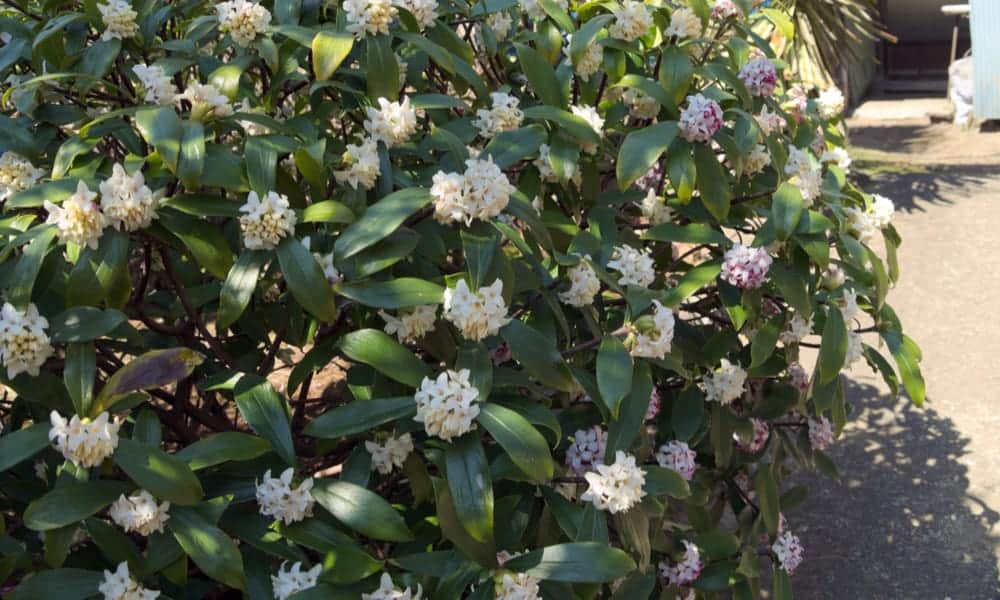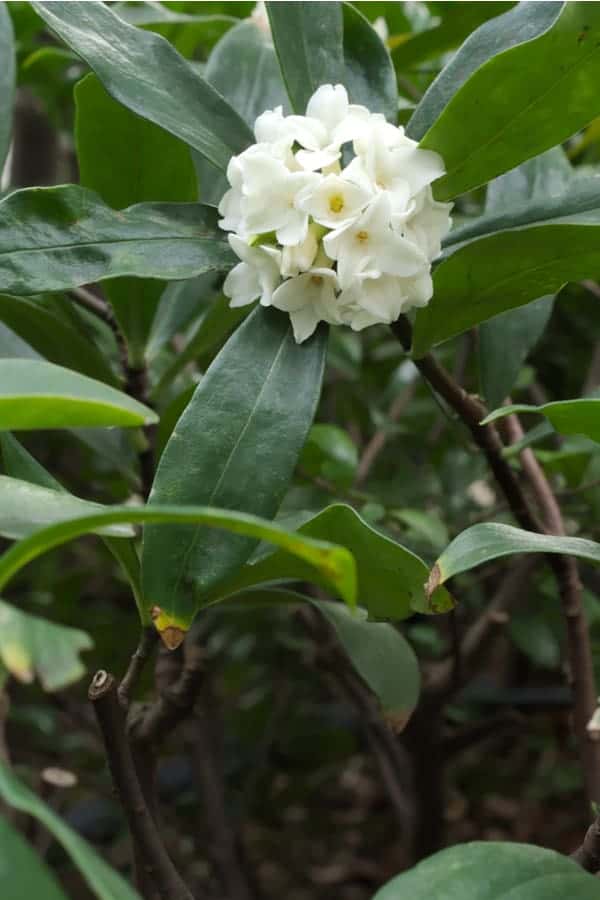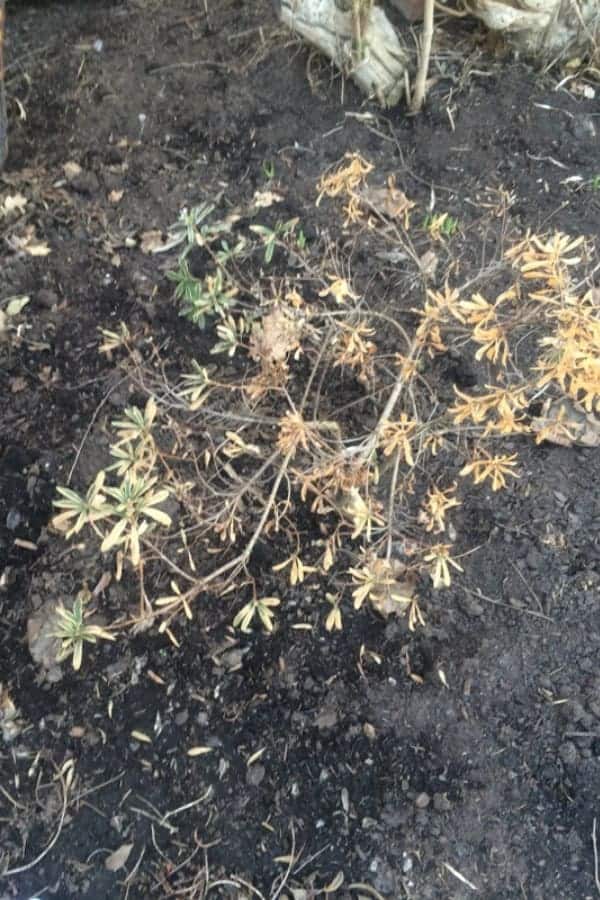Daphne shrub got its name after a Greek nymph. It is a sweet-smelling plant with attractive, dark-green and glossy foliage and brightly colored berries. I adore clusters of small, fragrant, white, yellow, lavender, or pink blooms all over the lovely, approximately 1 to 4 feet (30.5 cm – 1.2 m) tall bush.
If you decide to choose one of these lovely deciduous, evergreen, or semi-evergreen shrubs for your garden, you will have a serious job. There are approximately 75 to 90 species of Daphne growing all around the world. Some of them are really gorgeous, and you will love them. However, be careful with this plant since all its parts are toxic, especially the berries.
Best Daphne shrub Varieties
Daphne odora (Winter Daphne)

This is definitely the most fragrant variety of Daphne shrub in the world. I like the narrow, glossy foliage of this variety as well as its pink or purple blooms flourishing in February and March. You can expect it grows approximately 4 feet (1.2 m) tall.
If you want this particular plant, keep in mind that the sudden deaths of these bushes for no apparent reason have been well documented.
On the other hand, whichever of many variants of this Daphne you choose you won’t go wrong. All of them are fragrant and awesome. My favorite four are:
- Tall approximately 3 to 4 feet (0.9 – 1.2 m), ‘Marginata’ is unique because of the slight cream-colored edge of the foliage.
- ‘Maijima’ is also about 3 to 4 feet (0.9 – 1.2 m) tall with thick, creamy edges on leaves.
- With solid green foliage, ‘Zuiko Nishiki’ is a perfect choice for your garden. Its branching is stiffer and can reach a height of 4 feet (1.2 m).
- Finally, there is ‘Rebecca,’ a robust type with green foliage, edged with creamy gold, and fragrant winter blooms. It can reach up to 3.5 feet (1 m) height.
Daphne bholua

This variety is well-known for its long evergreen foliage and delicate pink, adorably fragrant flowers which bloom in late winter.
It can reach 8 feet (2.4 m) in height in the US, but it is not rare finding 30 feet (9 m) tall plants in their native Nepal.
Ma favorite types are:
- ‘Peter Smithers’ is a 6 feet (1.8 m) tall evergreen shrub blooming in mid-winter. I enjoy its clusters of purple-pink buds. The interesting thing is that they open to pale flowers, which become darker over time.
- ‘Darjeeling’ is a 6 feet (1.8 m) tall semi-evergreen shrub. Lovely, pointed, mid-green foliage is properly spaced across the tan-colored stems. The best parts are fragrant clusters of pale-pink flowers, which will fade to white over time.
- I like ‘Jacqueline Postill’ Daphne bholua. That evergreen bush has beautiful shiny leaves and large clusters of mauve-pink blooms. Grow this plant and enjoy its powerful sweet fragrant flowers lined up along the 6 feet (1.8 m) tall stems.
- Rich white flowers of ‘Limpsfield’ are unusual because of purple-pink flower edges. This fragrant evergreen shrub, which can reach up to 6 feet (1.8 m) height, blooms from mid-winter.
Grow this type of Daphne near your home and provide an excellently sheltered position for it. In turn, you will enjoy the beauty and scent of this fantastic plant for a long time.
Daphne mezereum f. alba

With small, narrow foliage on upright, 35 inches (89 cm) tall stems, this deciduous shrub is unusually beautiful. I adore its star-like, seductive clusters full of flowers blooming in winter. After they wilt, you can enjoy the bush full of yellowish berries.
Daphne causcasia

Flowers of this, 4 feet (1.2 m) tall, deciduous shrub flourish from late spring to early fall. You will love its clusters of white, fragrant blooms followed by lovely yellow berries.
Daphne cneorum (Garland Daphne)

Less than 1 foot (30.5 cm) tall, this dwarf shrub is extremely popular as a fragrant part of rock gardens. You will enjoy its large clusters of pink flowers and narrow and light green evergreen foliage.
If it is appropriately sheltered, this lovely variety will develop its sweetly fragrant blossom from mid-spring to the very beginning of summer.
Daphne pontica

This tiny, 20 inches (50.8 cm) tall evergreen shrub spreads best below the light shade of trees. You can enjoy large clusters of yellowish flowers producing among glossy green foliage in late spring.
How to Plant Daphne Shrub in Your Garden
Propagation

It is not easy planting Daphne shrub, and you probably can’t do it by yourself, especially if you are an inexperienced gardener. It is possible to propagate this bush in three different ways:
- Grafting – This method includes combining Daphne shrub sprout with the roots of another plant. That will provide vigor and resilience to your shrub. The best time for this is late winter.
- However, this task is highly demanding, and the better solution is to purchase already grafted plant on a rootstock.
- Semi-ripe heel cuttings – This way of propagation is not too complicated. Even novices can do it in mid-summer without any particular skills or special equipment.
- From seeds – After removing the fleshy exterior, you should sow seeds in a pot filled with compost and added grit. Provide a sheltered, shady, and cool place for the pot and wait approximately two years to your seeds germinate.
Grow Daphne shrub from cuttings

It is the most convenient way to grow Daphne shrub on your own. Take a pot of 4 inches (10 cm) in diameter and fill it with well-mixed compost and perlite in a ratio of 4:1.
Moist the mix with enough water, then press its surface to squeeze the excess liquid. Make 3 inches (7.6 cm) deep hole in the center of that mix.
Use bypass shears and cut the 6 inches (15 cm) long cutting from the bush, below the foliage. Move the leaves from the base and dip the cut tip in rooting hormone talc.
Place the cutting in the hole made in the compost mix, and take care that stem is positioned upright. Find a protected place with partial shade in your garden, and place the pot there.
Water the cutting until it takes roots in four to six weeks. Grow it in the rooting pot for 14 days, and transplant the new plant into a partially shaded bed. It will take about a month for establishing a viable root system.
How to Care Daphne Shrub
Space
Since this shrub won’t tolerate any displacement after planting, it is better picking out the right place on time.
Soil
Daphne shrub needs well-drained soil with a neutral to acidic pH. Humus will fit your bush excellently. However, if the ground is loamy or sandy, you should add some mature compost and water it well.
There are two exceptions. Daphne mezereum and Daphne laureola can tolerate claylike soils. However, they will do better if you add some fertilizer and help them thrive and grow healthy.
Light

Daphne needs the partial sun and enough shade during hot afternoons in summer. Some varieties, such as Daphne laureola prefers full shade. If you provide enough light for your plant, it will bloom abundantly and make your garden beautiful and unique.
Temperatures
Most of the varieties are exceptionally frost hardy. Some of them can survive even the temperatures of -3 F (-19.5 C).
Watering

Your Daphne needs the damp ground to bloom abundantly. Water your shrub regularly, especially during summer, when there is not enough rainfall.
Check the level of moisture before every watering to prevent overwatering. Keep in mind that your plant will tolerate short periods of drought better than soggy soil.
Fertilizing
In general, your plant won’t need too much fertilizer, because there is a possibility of the pH balance disturbance.
It will be enough adding high-quality fertilizer twice a year to grow Daphne successfully. The best moments for feeding your plant are February and July. A slow-release fertilizer will do the job, but try to avoid acidic ones.
Mulching

You need to find a way to keep roots of your Daphne consistently moist. Therefore, adequate mulching will be an ideal solution, but take care to keep the material away from the stem to prevent rot problems.
Spread a layer of 3 inches (7.6 cm) of well-rotted organic mulch around your plant. The best options are chopped leaves, wood chips, or shredded bark.
Pruning

Daphne shrub doesn’t require hard pruning, and this activity shouldn’t become a part of annual plant care. You just need to cut it to make some corrections when necessary. Do it in early spring if you grow winter varieties. Otherwise, the better moment is late spring.
Be careful since this bush never responds well to too much pruning, which may lead to its death. Your job is to use pruning shears and cut off damaged branches and the parts of the plant affected by the disease.
When you prune the tips of the new, longer shoots, you will help your plant to thrive and become fuller. However, take care not to cut parts crucial for blooming.
Daphne Shrub Pests and Diseases
Sudden death
Believe it or not, Daphne shrub tends to die suddenly without an apparent reason. Most commonly, it is about improper cultivation since this plant is highly sensitive to its environment.
It may die out because of overwatering, too much fertilizer, and sudden change in the temperatures. However, the reason can also be trivial, such as planting some other plant nearby. If you experience this problem, you will probably never know the primary cause.
Burned foliage

The most common reason for this condition is dog urine. Urine ammonia will cause discoloration of leaves and branches, and kill the plant eventually.
If you have a pet, protect the foliage by spraying it with pet repellant. The problem is that these sprays may also kill your delicate Daphne shrub.
Aphids

These pear-shaped bugs may attack tender flower clusters of your Daphne. They will suck sap from the foliage, which will become curled and yellowish.
If our shrub loses its vigor, check for groups of these insects under the attacked leaves. If you find them there, start spraying the plant early in the morning three times a week. If the infection is severe, use a soap solution for that purpose.
Mealybugs

These harmful insects will attack the roots, foliage, and stems of your Daphne by making cottony white masses on it. As a result, infested leaves become unattractive and yellow.
Solve this unpleasant problem by applying alcohol-insecticidal soap spray every two days until you destroy all the pests. You may prevent this disease with light horticultural oil. Spray it in early spring before the new growth of your plant begins.
Southern blight
These fungi may become fatal for your Daphne when the pH of the soil is inadequate, and the temperatures become too high. They often affect very young shrubs without corky bark.
You will notice dark, discolored spots on the stem near the surface of the ground. Your plant will probably die approximately a month after the moment you see the first fungal threads. The only way to protect your shrub is effective prevention.

Leave a comment